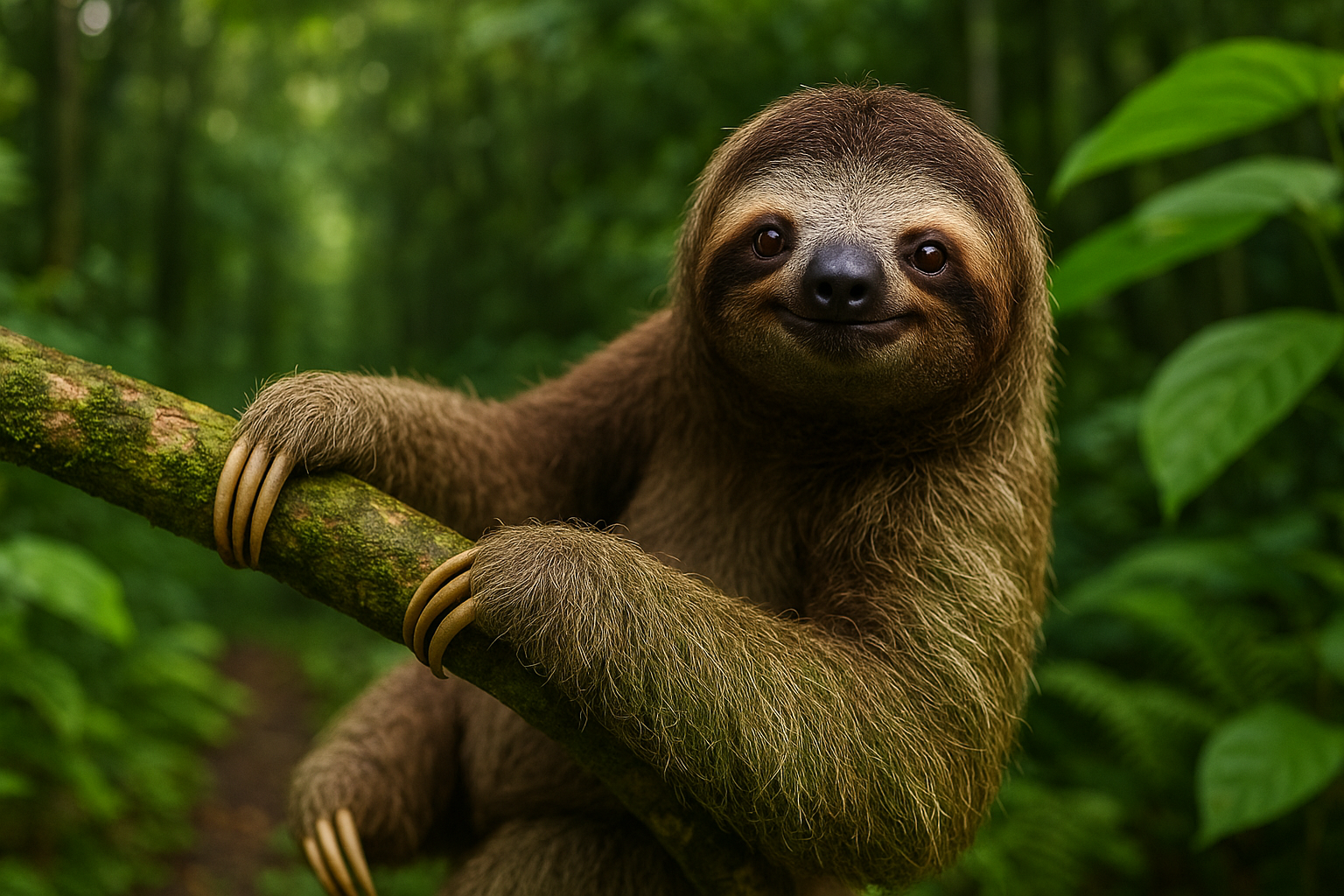
Excerpt
Chapter 1: Meet the Sloth!
At first glance, a sloth might look like a monkey. They have long arms, they live in trees, and they’re covered in thick fur. But they’re not monkeys. Not even close. Sloths belong to a special group of mammals called xenarthrans, which also includes armadillos and anteaters. Yep—those are their cousins.
But what really makes sloths stand out isn’t just who they’re related to. It’s how they move, how they live, and how they’ve totally leaned into being slow—really, really slow. They're not trying to win races. They’re trying to survive in a rainforest where moving like a statue actually works.
Here’s something surprising: sloths didn’t always look like they do now. Long ago, there were giant ground sloths that roamed across parts of North and South America. One kind was as big as a car and had huge claws. These giant sloths didn’t climb trees—they walked on the ground and ate plants with strong, chisel-like teeth. But those guys are gone now, and what’s left are smaller tree-dwelling sloths. They’re the ones we see today in places like Costa Rica, Panama, and Brazil.
Modern sloths come in two main styles: two-toed and three-toed. That doesn’t mean they only have two or three toes total. It refers to the number of toes on their front feet. Their back feet always have three. Weird, right? The two-toed sloths are a bit bigger, with a pig-like nose and a shaggy coat that makes them look like they just woke up from a nap. Three-toed sloths have little black markings around their eyes that make it look like they’re always smiling a sleepy smile.
You might think their faces look funny—and you’d be right—but their faces also hide something sneaky: sloths almost never show strong emotions. You won’t see them angry or surprised or even super happy. Their faces don’t really move that much. It makes them look calm all the time, even when they’re not. That “chill” look is just how their muscles are built.
And while most mammals are full of energy and always on the move, sloths take the complete opposite approach. They rest. A lot. They sleep up to 15 hours a day, and even when they’re awake, they don’t move much. It’s not because they’re lazy—it’s because they’ve built their entire lives around saving energy.
Here’s the deal: sloths eat mostly leaves. And leaves are kind of a lousy food source. They’re tough to chew and don’t have much energy in them. To survive on such a boring diet, sloths had to slow everything down. Their heart beats super slowly. Their bodies digest food slowly. Even their muscles are slow to react. That’s why they can’t sprint or leap or fight back quickly. But that’s also why they’ve stayed alive all these years.
Sloths also have a funny way of moving. Their legs aren’t very strong when it comes to standing or walking on flat ground. In fact, on the ground, they look like they’re doing an awkward belly crawl. But up in the trees, they’re in their element. Their long arms and curved claws let them hook onto branches and swing slowly from one to the next. They’re great climbers—even if it takes them a while to get where they’re going.
You wouldn’t think a sloth could be good at anything fast, but here’s a twist—they’re surprisingly strong swimmers. Really. In the water, they move three times faster than on land. Their long arms work like paddles, and they can hold their breath for up to 40 minutes. That’s longer than a dolphin!
And their fur isn’t just for staying warm. If you looked closely, you’d see that a sloth’s fur is kind of greenish in spots. That’s not dirt—it’s algae. Real plant-like stuff growing in their fur! Why? Because algae help them blend into the green trees they live in. It’s like natural camouflage. Plus, the algae feed some of the tiny bugs and beetles that live in their fur. Sloths don’t seem to mind. They’re like walking ecosystems.
They’re also very quiet animals. You’ll never hear a sloth roar or howl like some monkeys. They mostly stay silent. The only time they make noise is when baby sloths squeak to call for their moms, or if they’re in trouble. Other than that, silence is their style.
People often think sloths are simple because they’re slow. But that’s not true at all. They’ve got one of the most unusual survival plans in the animal kingdom. They don’t chase, they don’t run, they don’t show off. They just blend in, chill out, and wait for the world to pass by. It’s worked for millions of years.
Sloths aren’t pets, even though some people try to keep them like one. They need special trees, special diets, and lots of space. Holding or hugging a sloth can actually stress them out a lot. They like quiet forests, not busy homes. The best way to enjoy sloths is to learn about them, protect their homes, and let them do their thing.
They may look like they’re moving in slow motion, but everything about sloths is fine-tuned to help them survive in their own quiet, upside-down way. They're not broken. They're not behind. They're built differently—and it works.
At first glance, a sloth might look like a monkey. They have long arms, they live in trees, and they’re covered in thick fur. But they’re not monkeys. Not even close. Sloths belong to a special group of mammals called xenarthrans, which also includes armadillos and anteaters. Yep—those are their cousins.
But what really makes sloths stand out isn’t just who they’re related to. It’s how they move, how they live, and how they’ve totally leaned into being slow—really, really slow. They're not trying to win races. They’re trying to survive in a rainforest where moving like a statue actually works.
Here’s something surprising: sloths didn’t always look like they do now. Long ago, there were giant ground sloths that roamed across parts of North and South America. One kind was as big as a car and had huge claws. These giant sloths didn’t climb trees—they walked on the ground and ate plants with strong, chisel-like teeth. But those guys are gone now, and what’s left are smaller tree-dwelling sloths. They’re the ones we see today in places like Costa Rica, Panama, and Brazil.
Modern sloths come in two main styles: two-toed and three-toed. That doesn’t mean they only have two or three toes total. It refers to the number of toes on their front feet. Their back feet always have three. Weird, right? The two-toed sloths are a bit bigger, with a pig-like nose and a shaggy coat that makes them look like they just woke up from a nap. Three-toed sloths have little black markings around their eyes that make it look like they’re always smiling a sleepy smile.
You might think their faces look funny—and you’d be right—but their faces also hide something sneaky: sloths almost never show strong emotions. You won’t see them angry or surprised or even super happy. Their faces don’t really move that much. It makes them look calm all the time, even when they’re not. That “chill” look is just how their muscles are built.
And while most mammals are full of energy and always on the move, sloths take the complete opposite approach. They rest. A lot. They sleep up to 15 hours a day, and even when they’re awake, they don’t move much. It’s not because they’re lazy—it’s because they’ve built their entire lives around saving energy.
Here’s the deal: sloths eat mostly leaves. And leaves are kind of a lousy food source. They’re tough to chew and don’t have much energy in them. To survive on such a boring diet, sloths had to slow everything down. Their heart beats super slowly. Their bodies digest food slowly. Even their muscles are slow to react. That’s why they can’t sprint or leap or fight back quickly. But that’s also why they’ve stayed alive all these years.
Sloths also have a funny way of moving. Their legs aren’t very strong when it comes to standing or walking on flat ground. In fact, on the ground, they look like they’re doing an awkward belly crawl. But up in the trees, they’re in their element. Their long arms and curved claws let them hook onto branches and swing slowly from one to the next. They’re great climbers—even if it takes them a while to get where they’re going.
You wouldn’t think a sloth could be good at anything fast, but here’s a twist—they’re surprisingly strong swimmers. Really. In the water, they move three times faster than on land. Their long arms work like paddles, and they can hold their breath for up to 40 minutes. That’s longer than a dolphin!
And their fur isn’t just for staying warm. If you looked closely, you’d see that a sloth’s fur is kind of greenish in spots. That’s not dirt—it’s algae. Real plant-like stuff growing in their fur! Why? Because algae help them blend into the green trees they live in. It’s like natural camouflage. Plus, the algae feed some of the tiny bugs and beetles that live in their fur. Sloths don’t seem to mind. They’re like walking ecosystems.
They’re also very quiet animals. You’ll never hear a sloth roar or howl like some monkeys. They mostly stay silent. The only time they make noise is when baby sloths squeak to call for their moms, or if they’re in trouble. Other than that, silence is their style.
People often think sloths are simple because they’re slow. But that’s not true at all. They’ve got one of the most unusual survival plans in the animal kingdom. They don’t chase, they don’t run, they don’t show off. They just blend in, chill out, and wait for the world to pass by. It’s worked for millions of years.
Sloths aren’t pets, even though some people try to keep them like one. They need special trees, special diets, and lots of space. Holding or hugging a sloth can actually stress them out a lot. They like quiet forests, not busy homes. The best way to enjoy sloths is to learn about them, protect their homes, and let them do their thing.
They may look like they’re moving in slow motion, but everything about sloths is fine-tuned to help them survive in their own quiet, upside-down way. They're not broken. They're not behind. They're built differently—and it works.




